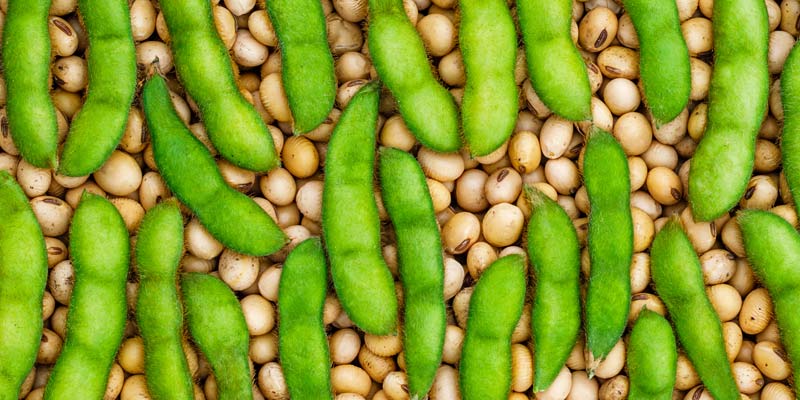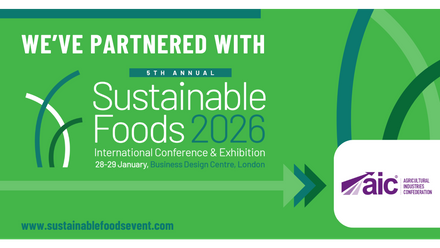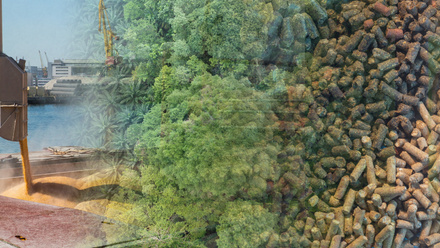FAQs: Feeding livestock with soya - why is it important and how sustainable is it?

Find the answers to frequently asked questions about soya production, its importance for livestock feed, UK import volumes and sustainability targets.
This resource was last updated in August 2023 to include Q1 2023 soyabean meal import data.
What is soya?
Soya, also known as soy, is a type of legume bean crop which is high in protien. It is grown for human consumption and livestock feed in many continents, including South America, North America, East Asia and some parts of Europe.
Although research to develop more soya varieties to be grown in the UK and the European Union is progressing, production is still at a relatively very small scale compared to North and South America.
Once harvested, soya beans are crushed to produce oil for human consumption or bio-fuel production, and the residual pulp, known as meal, is used for animal feed.
A soya bean is made of approximately 22% oil and 72.5% meal, with the hulls making up most of the residual.
Why is soya so important for livestock feed?
Soya, usually as soyabean meal, is used in animal feeds because of its unique characteristics in its amino acid profile, protein concentration, nutrient density, digestibility and palatability to livestock.
Given these characteristics, soya complements other feeds such as cereal grains. It also ensures less nitrogen being excreted in the manure from animals. It is therefore an essential part of livestock feed.
Which UK livestock sectors use soya?
The approximate breakdown of annual soyabean meal usage in UK livestock sector are show below.
|
UK Livestock Sector |
Total annual soyabean meal use (in tonnes) |
Average annual soyabean meal use in feed (%) |
|
Dairy |
360,000 |
7.3 |
|
Beef |
60,000 |
3.9 |
|
Pigs |
360,000 |
9.9 |
|
Poultry (meat) |
1,264,000 |
21.0 |
|
Poultry (eggs) |
210,000 |
11.2 |
|
Sheep |
30,000 |
2.4 |
|
Equine |
5,000 |
3.0 |
|
Fish |
47,000 |
13.4 |
|
Other |
51,000 |
10.4 |
|
Total |
2,378,000 |
9.17 (average) |
*Data provided by AIC
The figures here reflect the volumes of soyabean meal used in UK livestock feeds and do not account for other uses of soya.
Where does imported soya come from?
The majority of imported soya comes from Argentina, Brazil, United States, Canada and Paraguay. UK Soya import data (see supply data in the annex below), collated by AIC, shows that 65.1% of soya imported for animal feed can be considered verified deforestation and conversion free.
This means it is covered by zero-deforestation standards set by soya scheme owners or covered by Amazon Soy Moratorium (ASM) contracts or grown in territories with no deforestation risk (such as USA and Canada).
Of the remaining 34.9% of imports, 7.6% can be considered deforestation and conversion free but this cannot, yet, be verified and research shows that of the remaining 27.3%, using a methodology developed by FEFAC in conjunction with CIARA in Argentina, ABIOVE in Brazil and CAPRO in Paraguay, 24.3% would be regarded as carrying a low risk of deforestation.
This leaves 3% of UK imported soya that carries a risk of deforestation.
Are there alternative feeds to soya?
The animal feed and UK livestock sectors have taken great strides to reduce their reliance on imported soya. For example, in the past 10 years the British pig sector has halved its soya use.
Livestock feed is made up of cereals, pulses, oilseeds and their co-products which are non-edible for humans2, products from the food industry (bread, pasta etc), grass and silage feed additives such as minerals, trace elements and vitamins.
None of these alone however provide the same amino acid profile, nutrient density or digestibility to animals as soya, which is why they are used in combination in rations.
There is considerable research taking place into novel proteins, such as insects, algae and single cell proteins. These sectors are in their infancy and significant investment is required to scale up and develop a catalyst to these technologies.
It should also be noted that retained EU legislation does not allow insect protein to be fed to pigs and poultry (it is only authorised for pets and fish).
2 Many cereal crops in the UK do not meet human quality specifications. The only viable outlet for such crops is animal feed.
What is being done to ensure soya is sustainable?
Certified soya is available to the market, through a range of systems such as "credit" schemes or "chain of custody" standards that follow the physical supply.
In addition to this, The European Feed Manufacturers' Federation (FEFAC) formed a coalition of members in 2014 to develop the FEFAC Soy Sourcing Guidelines [PDF].
These consist of social and environmental criteria and recommendations for good agricultural practices for soya cultivation. There are now 19 benchmarked schemes compliant with FEFAC guidelines.
In 2023, the Guidelines were updated so that the criterion on the protection of natural ecosystems (deforestation and conversion free) has become an essential requirement.
FEFAC Certified schemes do attract additional costs, and these costs will fall to the supply chain to be able to absorb them.
In the UK, the Roundtable on Sustainable Soya was established in 2018 to provide the UK industry with an open forum to work together towards a secure, resilient, supply of deforestation free sustainable soya to the UK.
The UK Roundtable now comprises over 30 members, including major supermarkets, processors, farming organisations, feed businesses, foodservice businesses and soya traders.
More recently, UK retailers and food processors representing 60% of the UK soya consumption have committed to verified deforestation and conversion free (vDCF) soya through the UK Soy Manifesto.
All stakeholders, including the soya importers and the feed industry are working to deliver a viable national transition plan towards vDCF soya. Find out more on the UK Soy Manifesto website.
As part of this transition plan, AIC and its soya shipper/importer Members have agreed to collect quarterly data on the sustainable status of soya coming into the UK. The annex below provides data for Q1 2023 imports.
How can the Government’s Due Diligence legislation under the Environment Act help sustainable soya?
The UK Government has accelerated its own commitments on illegal deforestation with support for the UK Roundtable on Sustainable Soya and a plan to introduce a requirement for due diligence for large companies handling ‘forest commodities’ within the Environment Act.
AIC supports the objective of preventing the import of commodities which have been produced on land that has been deforested illegally, and it is AIC's view that there is a role for government in helping to prevent this.
The challenge now is to ensure that the legislation is well targeted, and can work with supply chains, farming businesses and retailers.
The legislation must take account of imported products carrying ‘embedded’ soya (such as processed foods or imported meat) and ensure they are clearly under scope.
Failure to consider this at all could lead UK farming businesses placed at a competitive disadvantage on food standards.
Annex: AIC Soya Supply Group Import Data Report – May 2025
The AIC Soya Supply Group (ASSG) together with the AIC Sustainable Commodities Standard Working Group (ASCSWG) have been engaged in a number of initiatives relating to sustainable soya for several years and provide this report by way of an update on recent activity.






